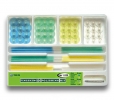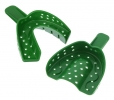OBJECTIVES
The aim of this study was to determine whether a diagnosis of osteoporosis affected the survival rate of osseointegrated dental implants. Other variables that were studied were age, arch location of the implant, and smoking status on the effect of dental implant survival
MATERIALS AND METHODS
A retrospective chart review was completed on all women who were 50 years of age or older at the time of dental implant placement at the Mayo Clinic between October 1, 1983, and December 31, 2004 Osteoporotic status was defined on the basis of bone mineral density (BMD) score utilizing World Health Organization criteria. Univariate analyses were performed to evaluate the following independent variables' effect on implant survival: BMD T-score, age, osteoporosis status, arch location of the implant, and smoking status at the time of implant placement
RESULTS
A total of 3,224 implants in 746 female patients 50 years of age or older at the time of implant placement were evaluated. BMD scores within 3 years of implant placement were available for 646 implants (192 patients). In this group, 37 implant failures were noted. The 5-year implant survival rate was 93.8% in the group of patients with BMD scores. In this group of 192 patients, there were 94 (49%) who were not diagnosed with osteopenia or osteoporosis, 57 (29.7%) with a diagnosis of osteopenia, and 41 (21.4%) with a diagnosis of osteoporosis. Patients with a diagnosis of osteoporosis or osteopenia were not significantly more likely to develop implant failure compared to those without such a diagnosis (HR = 1.14, 95% CI = 0.50 to 0.60, P = .76 and HR = 0.98, 95% CI = 0.40 to 2.42, P = .97 respectively). Arch location and BMD score did not have a statistically significant effect on implant survival rates. The only tested variable to demonstrate a significant effect was smoking. Implants in patients who were smokers during the time of implant placement were 2.6 times more likely to fail compared to implants placed in patients who did not smoke (HR = 2.6, 95% CI = 1.20 to 5.63; P = .016
CONCLUSIONS
Based upon the data derived from this retrospective study of 192 women at least 50 years of age at the time of implant placement, the following observations were made: (1) a diagnosis of osteoporosis and osteopenia did not contribute to increased risk of implant failure and (2) implants placed in patients who were smokers at the time of implant placement were 2.6 times more likely to fail than implants placed in nonsmokers. Based on these data, a diagnosis of osteoporosis or osteopenia is not a contraindication to dental implant therapy
Source: 19014161 PubMed - indexed for MEDLINE
Publication date: 2008 Oct 23





